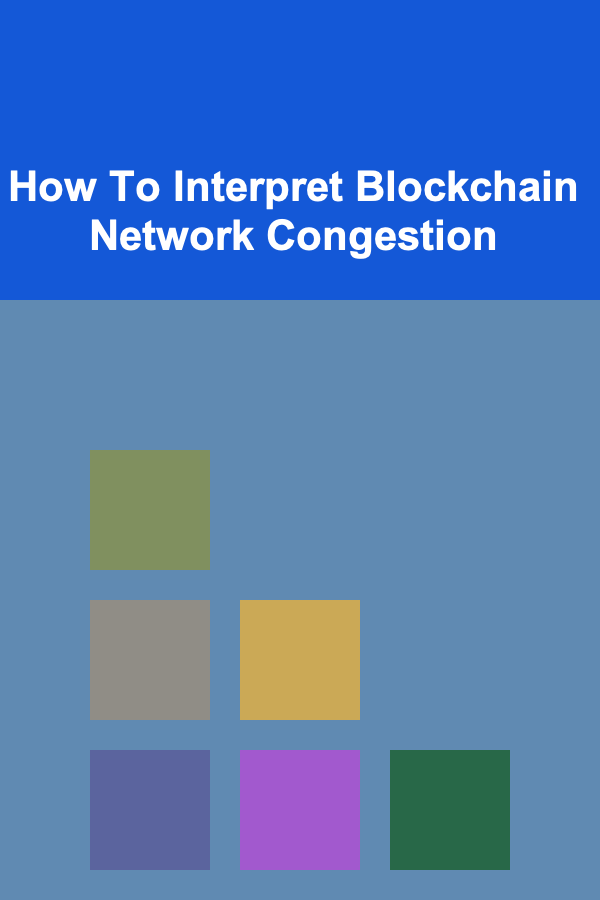
How To Interpret Blockchain Network Congestion
ebook include PDF & Audio bundle (Micro Guide)
$12.99$6.99
Limited Time Offer! Order within the next:

Blockchain technology has evolved from being a concept mainly associated with cryptocurrency to a transformative force that has the potential to reshape multiple industries. One critical aspect of blockchain technology is its decentralized nature, which enables transparency, security, and trust. However, as the technology has grown in popularity, new challenges have emerged, including blockchain network congestion.
Network congestion in the context of blockchain refers to a situation where the number of transactions exceeds the network's capacity to process them in a given period. This issue can have far-reaching consequences on the performance, cost, and user experience of blockchain applications. Understanding blockchain network congestion is crucial for developers, investors, and businesses that rely on blockchain-based systems. In this article, we will explore the phenomenon of blockchain network congestion, its causes, its impact, and the ways it can be mitigated.
What is Blockchain Network Congestion?
Blockchain network congestion occurs when the demand for processing transactions exceeds the network's capacity. Blockchain systems, particularly those that are widely used such as Bitcoin, Ethereum, and others, have a finite capacity to handle transactions. This capacity is influenced by several factors, including block size, transaction fees, consensus mechanisms, and network protocols.
When the number of pending transactions in the network exceeds the system's processing capabilities, congestion sets in. Transactions that are not included in the current block get queued in the mempool (memory pool), where they remain until they are eventually processed by miners or validators. If the mempool grows too large, users may experience delays, higher transaction fees, or even failures in transaction execution.
Congestion in a blockchain network can be a temporary issue during periods of high demand, or it can be a persistent problem depending on the scalability of the network and the design of its consensus mechanism. Understanding congestion requires analyzing several components that influence transaction throughput, network latency, and scalability.
Causes of Blockchain Network Congestion
There are several factors that contribute to network congestion in blockchain systems. These factors can be categorized into technical limitations of the network and external influences such as sudden increases in demand.
1. Block Size Limitations
Most blockchain networks, including Bitcoin, have a fixed block size, which limits the number of transactions that can be included in a single block. For example, Bitcoin's block size is limited to 1 MB, meaning that only a certain number of transactions can be processed in each block. As the popularity of the network grows, more transactions are generated, and this fixed block size becomes a bottleneck.
When the block size is exceeded, unprocessed transactions are pushed into the mempool, causing congestion. In times of high activity, like during the price surges of Bitcoin, congestion can become particularly noticeable.
2. Transaction Fees
Transaction fees play a critical role in managing congestion in blockchain networks. Miners or validators prioritize transactions that offer higher fees, as they are financially incentivized to include transactions with the highest fees in the blocks they process. During periods of congestion, users may need to increase their transaction fees to ensure that their transactions are processed in a timely manner. If many users are competing for block space by offering higher fees, the overall transaction fees may rise significantly.
This creates a feedback loop where users must continually adjust their transaction fees based on network activity, further exacerbating the congestion problem. In extreme cases, users with lower fees may see their transactions remain unprocessed for extended periods.
3. Consensus Mechanisms
The consensus mechanism used by a blockchain network is also a critical factor influencing its ability to handle congestion. Blockchain networks rely on consensus mechanisms to agree on the state of the ledger and validate transactions. The two most common consensus mechanisms are Proof of Work (PoW) and Proof of Stake (PoS).
- Proof of Work (PoW): PoW requires miners to solve complex cryptographic puzzles in order to add a block to the blockchain. This process can be resource-intensive, and the rate at which new blocks are added to the chain is fixed. Bitcoin, for example, uses PoW, and as the network grows, the fixed block time (approximately 10 minutes) means that there is a limited rate at which transactions can be processed.
- Proof of Stake (PoS): In PoS-based systems, validators are chosen to create new blocks based on the amount of cryptocurrency they hold and are willing to "stake" as collateral. While PoS systems tend to be more energy-efficient, they also have limitations in terms of transaction throughput, which can contribute to congestion during times of high demand.
4. Network Latency and Throughput
Network latency refers to the time it takes for data to travel across the network. In the context of blockchain, network latency can affect the speed at which transactions are broadcast to the network and subsequently added to the blockchain. High latency can lead to delays in transaction processing, which can exacerbate congestion.
Throughput, on the other hand, refers to the rate at which transactions can be processed by the network. A low throughput rate means that the network can handle fewer transactions per second, making it more susceptible to congestion. For instance, Bitcoin's transaction throughput is limited to around 7 transactions per second (tps), while Ethereum can process around 30 transactions per second under its current state. As blockchain networks expand and more users join, these throughput limits become a critical bottleneck for transaction processing.
5. DApps and Smart Contracts
The rise of decentralized applications (DApps) and smart contracts on blockchain networks has introduced additional complexity and strain on the network. DApps rely on blockchain networks to execute transactions and logic. In many cases, smart contracts require multiple transactions to execute, which can overload the network if not properly managed.
Ethereum, in particular, has faced significant congestion due to the popularity of decentralized finance (DeFi) applications and non-fungible token (NFT) platforms. These applications often require numerous interactions with the blockchain, leading to increased demand for block space and processing power, thereby contributing to congestion.
Impact of Blockchain Network Congestion
Blockchain network congestion can have several negative effects, ranging from slow transaction processing to increased transaction costs. These impacts can affect individual users, businesses, and entire industries that depend on blockchain for various use cases.
1. Increased Transaction Fees
One of the most immediate effects of network congestion is the rise in transaction fees. As miners prioritize transactions with higher fees, users must increase their fees to ensure their transactions are included in the next block. This can make blockchain networks more expensive to use, especially during times of high demand. In some cases, the cost of using a blockchain network can become prohibitive, particularly for smaller transactions.
2. Delayed Transactions
Congestion can result in delayed transactions, as users wait for their transactions to be included in the blockchain. This can be particularly frustrating for users who rely on fast transaction processing for applications such as remittances, microtransactions, or financial services. The delay in transaction processing can harm the user experience and reduce the overall reliability of the blockchain network.
3. Lower Network Security
Network congestion can also have implications for the security of the blockchain network. When the mempool becomes overly congested, there is a higher risk of transaction malleability and double-spending attacks. In times of congestion, malicious actors may exploit vulnerabilities in the network to conduct fraudulent transactions, undermining the trustworthiness of the blockchain.
4. Decreased Scalability
Scalability is one of the most critical challenges for blockchain networks. Congestion can reveal the limitations of a blockchain network's scalability, as the network becomes less able to handle increased demand. In the long term, this can result in a network that is unable to grow to accommodate an increasing number of users, limiting its adoption and use cases.
How to Mitigate Blockchain Network Congestion
Several strategies can be employed to mitigate blockchain network congestion. These solutions focus on improving the scalability, efficiency, and throughput of blockchain networks.
1. Layer 2 Solutions
Layer 2 solutions are built on top of the base blockchain to increase transaction throughput and reduce congestion. These solutions allow transactions to be processed off-chain, reducing the burden on the main blockchain.
- The Lightning Network (Bitcoin): The Lightning Network is a popular Layer 2 solution for Bitcoin that enables fast, low-cost transactions by creating off-chain payment channels between users. By allowing transactions to be settled off-chain, the Lightning Network reduces congestion on the main Bitcoin blockchain.
- Optimistic Rollups and ZK-Rollups (Ethereum): Optimistic Rollups and ZK-Rollups are Layer 2 solutions for Ethereum that aggregate multiple transactions into a single transaction, reducing the number of transactions that need to be processed on the main chain. These solutions significantly increase Ethereum's throughput and reduce congestion.
2. Increasing Block Size
One solution to increasing transaction capacity is to increase the block size limit. Bitcoin Cash, a fork of Bitcoin, increased the block size limit from 1 MB to 32 MB in an effort to reduce network congestion. Increasing the block size allows more transactions to be included in each block, improving throughput and reducing delays.
However, increasing block size also introduces trade-offs, including higher storage requirements for nodes and potential centralization risks, as larger blocks may require more powerful hardware to process.
3. Improved Consensus Mechanisms
Transitioning to more efficient consensus mechanisms, such as Proof of Stake (PoS) or hybrid models, can help improve scalability and reduce congestion. Proof of Stake networks, like Ethereum 2.0, are designed to handle more transactions by utilizing a different method of validating transactions.
In PoS, validators are chosen to create new blocks based on their staked assets rather than computational power. This approach is more energy-efficient and can increase transaction throughput while reducing congestion.
4. Sharding
Sharding is a technique used to divide a blockchain network into smaller, more manageable pieces, called shards. Each shard processes a subset of the network's transactions, allowing the overall system to handle more transactions in parallel. Ethereum 2.0 plans to implement sharding to improve scalability and reduce network congestion.
Sharding helps distribute the load across the network, increasing its capacity to process transactions without overwhelming any single node or component.
5. Optimizing Transaction Fees
Transaction fees can be optimized by implementing dynamic fee structures that adjust based on network congestion. Ethereum's EIP-1559 upgrade introduced a dynamic fee market that automatically adjusts the base fee based on network demand. This helps to stabilize transaction fees and reduce the likelihood of extreme price fluctuations during periods of congestion.
6. Off-Chain Solutions and State Channels
Off-chain solutions and state channels allow users to conduct transactions off the blockchain while maintaining the security guarantees of the main network. State channels are particularly useful for applications that require frequent transactions, such as gaming or microtransactions.
By moving transactions off-chain, these solutions reduce congestion on the main blockchain and enable faster, cheaper transactions.
Conclusion
Blockchain network congestion is a significant challenge that can affect the performance, cost, and usability of blockchain systems. Understanding the causes of congestion, such as block size limitations, transaction fees, consensus mechanisms, and network throughput, is essential for interpreting and addressing this issue. Solutions such as Layer 2 solutions, increased block size, improved consensus mechanisms, sharding, and optimizing transaction fees can help alleviate congestion and improve the scalability of blockchain networks.
As blockchain technology continues to evolve, addressing network congestion will be a key factor in its widespread adoption. By employing a combination of technical innovations and smart design choices, blockchain networks can overcome congestion challenges and provide users with a seamless, scalable, and efficient experience.
Reading More From Our Other Websites
- [Home Renovating 101] How to Install a Beautiful Deck: A Comprehensive Guide
- [Horseback Riding Tip 101] Best Tips for Riding in High Altitude Environments without Causing Rider Fatigue
- [Home Storage Solution 101] How to Store Kids' Toys in a Fun and Functional Way
- [Biking 101] How to Set Up a Bike Repair Stand for Easy Repairs
- [Home Space Saving 101] How to Save Space in Your Garage with Organized Storage Solutions
- [Home Budget 101] How to Identify the Best Free Online Budget Tool for Beginners
- [Sewing Tip 101] The Science of Stretch: How Knit, Jersey, and Spandex Fabrics Perform Differently
- [Personal Care Tips 101] How to Apply Moisturizer to the Face and Neck: A Step-by-Step Guide
- [Rock Climbing Tip 101] From Crux to Confidence: Building Skills and Safety Habits in Young Climbers
- [Home Renovating 101] How to Create a Mudroom on a Budget

How to Use Food and Drink Stations to Elevate Your Home Party
Read More
Travel Agent's Handbook: A Comprehensive Guide to Booking and Client Satisfaction
Read More
How To Explore the History of Ancient Japan
Read More
How To Offer Computer Repair Services: A Comprehensive Guide
Read More
How to Develop a Political Campaign Budget That Works
Read More
How to Land Content Writing Clients on LinkedIn
Read MoreOther Products

How to Use Food and Drink Stations to Elevate Your Home Party
Read More
Travel Agent's Handbook: A Comprehensive Guide to Booking and Client Satisfaction
Read More
How To Explore the History of Ancient Japan
Read More
How To Offer Computer Repair Services: A Comprehensive Guide
Read More
How to Develop a Political Campaign Budget That Works
Read More